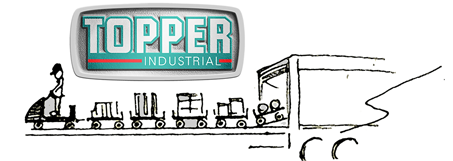![]() Several major manufacturers have a top down edict that all new lines will be FTF (fork truck free). This is driven by the desire to meet the demands of complexity, kitting, and efficiency while increasing safety, reducing line side inventory, delivering parts accurately, and increasing quality.
Several major manufacturers have a top down edict that all new lines will be FTF (fork truck free). This is driven by the desire to meet the demands of complexity, kitting, and efficiency while increasing safety, reducing line side inventory, delivering parts accurately, and increasing quality.
There are various causes of forklift related accidents, including operator distraction, visibility issues, and operator error (very similar to causes of automobile road accidents). Forklift operators are constantly barraged with interruptions such as other forklifts, line operators’ requests, and route alterations. Visibility can be an issue as they often have an obstructed view over obstacles or stock areas, which can lead to forklift overturns and accidental run-ins with other employees or objects.
Training initiatives, meticulously review safety protocols, reviewed and revised standard operating procedures (SOPs), have not eliminated the dangers that forklifts present to manufacturers. After decades of systematic process improvements in the use of forklift operations in warehouses, distribution centers, and manufacturing plants, many companies, industry leaders, and politicians are concluding that forklift-free environments may be the only fail-proof approach to ensuring safety.
No manufacturer designs any product or process without consideration to safety of the employees making the product, the ingredients or parts assembled to make a product, or the end-user customer utilizing the product. Adding to the safety focus are a wide range of regulatory and compliance laws and enforcement mechanisms to ensure the least amount of injury. Despite all these efforts, every year hundreds of people are killed using forklifts worldwide. Federal OSHA estimates that in the United States alone, there are nearly 100 worker fatalities and another 20,000 seriously injured in forklift-related incidences annually. OSHA estimates that there are 110,000 forklifts accidents each year and $135 million immediate costs are incurred due to forklift accidents.
Approximately every three days, someone in the U.S. is killed in a forklift related accident and almost 80% of forklift accidents involved a pedestrian. One-sixth of all workplace fatalities in the U.S. are forklift related.
According to Topper Industrial, the fork truck free approach will work for any company that operates production lines and processes that are normally fed materials using forklifts; many leading companies are considering these new vision-guided driverless options. For more than twenty years, Topper Industrial, (www.TopperIndustrial.com) based just outside of Milwaukee, WI, has been a leader in ensuring safety first material handling equipment. The company’s product roster features industrial carts, conveyors, lifts, lifts & tilts, shipping racks, containers, casters, and cart components. Topper products keep material moving from the dock to the cart to the assembly line. While working with so many major manufacturers across North America, the importance of ergonomics and safety is top priority when designing custom solutions for clients.
Topper Industrial recently announced a partnership with Seegrid vision guided vehicles (VGVs) providing benefits that make sense for companies suited for a forklift-free environment in terms of both reducing employee injuries and deaths, to reducing production costs through lean manufacturing. Given these additional cost burdens, safety considerations, and lean manufacturing initiatives, there is pressure to seek alternatives to forklifts, especially where VGVs can accomplish the same job (material flow and movement) as they prove to be safer, more productive, and efficient than traditional forklifts.
Fork Truck Free Environments Boost Productivity and Profitability
Beyond the serious and very real safety concerns (most critical) there are real costs associated with forklift operations. There are extensive additional costs for operator training, plant layout restrictions due to forklift aisles, damage to facilities and parts, maintenance, and fuel that can add up quickly.
The primary function of a forklift is to take advantage of vertical stacking and to transition product from alternate heights. Yet the vast majority of forklift activity and utilization is driving horizontally, not lifting vertically.
2016: The Year of FTF
Given these extensive safety considerations, additional cost burdens, and underutilization, there is pressure to aggressively seek alternatives to forklifts that can accomplish the same job (material flow and movement) which are safer, less expensive, and offer improved utilization.

A tugger and cart system can easily move six carts at a time, whereas a forklift truck typically moves one pallet or container at a time. Properly designed systems can reduce traffic by more than 80%; these metrics create immediate process improvements impacting the bottom-line. To efficiently deliver the larger variant of parts, manufacturers need to move to products in smaller lot deliveries. Forklift trucks are ill-suited for this task, whereas carts can be designed for tugger systems customized for a wide range of tote and bin deliveries, providing the necessary and essential flexibility.
Obviously there is no greater concern than the safety, health, and lives of workers. Profits, while very important, are secondary to lives. The notion of safety and profitability are not mutually exclusive. Avoiding costly worker’s compensation costs, wrongful death and injury lawsuits, and reducing a wide variety of injury-related costs, allow organizations to utilize resources to improve safety, productivity, product quality, and overall business competitiveness.
Because Topper Industrial understands the importance of safety, the company supports a FTF approach (www.forktruckfree.com). The Topper Industrial client roster includes Anderson Windows, Detroit Diesel, Honda, Kia Motors, Ford, Chrysler, Aramark, Johnson Controls, Whirlpool, and Caterpillar.
Article Courtesy:
TR Cutler, Inc.
Thomas R. Cutler
President & CEO



No Comments Yet!
You can be first to comment this post!